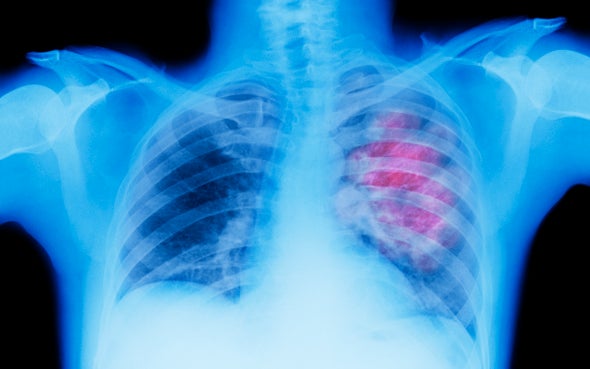(单词翻译:单击)
听力文本
This is Scientific American's 60-second Science, I'm Wayt Gibbs.
Imagine getting screened for early-stage lung cancer simply by taking a deep breath from an inhaler and then peeing into a cup.
Sangeeta Bhatia, a professor of health sciences and engineering at M.I.T., described how that might be possible in a TED talk she gave in 2016:
"What if you had a detector that was so small that it could circulate in your body, find the tumor all by itself and send a signal to the outside world? It sounds a little like science fiction. But actually, nanotechnology allows us to do just that."
Bhatia's idea was to invent nontoxic nanoprobes that doctors could put inside your blood or lungs or gut to detect tiny tumors when they're easier to treat—before they grow big enough to spread throughout the body and damage vital organs.
"I dream that one day, instead of going into an expensive screening facility to get a colonoscopy or a mammogram or a pap smear, that you could get a shot, wait an hour and do a urine test on a paper strip."
In 2017 Bhatia's team reported a proof-of-concept experiment in Nature Biomedical Engineering that demonstrated nanoprobes like this working to detect early-stage ovarian cancer in mice.
And now the group has refined this technology further to create a screening test for lung cancer that is more sensitive than the CT scans used today. The team of Harvard and M.I.T. researchers described their work in the April 1 issue of Science Translational Medicine.

Lung cancer accounts for nearly a quarter of all cancer deaths in the U.S. each year, in large part because most cases of lung cancer are not caught until after the disease has already spread to other sites.
Yet when lung cancer is caught and treated early, the majority of patients survive the disease for at least five years. But CT screening for lung cancer is not widely used around the world, because it's expensive, and more than 90 percent of positive tests turn out to be benign growths, not cancer. So this kind of screening leads to a lot of unnecessary and invasive biopsies.
In Bhatia's study, which was done on mice genetically engineered to develop lung tumors very similar to those seen in people, the nanoprobes were able to detect tumors about 50 times smaller than other screening methods. And it produced no false positives.
The nanoprobes are designed to release reporter molecules when they come near certain kinds of lung tumors. Once released, the reporters pass into the blood, get filtered out by the kidneys and then exit the body in the urine.
The group is now working to repackage the nanoprobes into a form that could be inhaled as a powder or through a nebulizer. If that succeeds, then the technology will have to proceed through several years of clinical trials before it could be used to screen people for lung cancer.
"And I hope that what this mean is that is that one day we can detect tumors in patients sooner than 10 years after they've started growing... and that this would lead to earlier treatments and that we could save more lives than we can today with early detection."
Thanks for listening for Scientific American's 60-second Science. I'm Wayt Gibbs.
参考译文
这里是科学美国人——60秒科学系列,我是维特·吉布斯。
想象一下,只用吸入器深吸一口气然后往杯子里排尿,就可以进行早期肺癌筛查。
麻省理工学院健康科学与工程系的教授桑吉塔·博蒂亚在2016年的TED演讲中描述了这一可能性:
“如果有个非常小的探测器,可以在你体内循环,找到肿瘤并向外界发出信号,会怎么样?这听起来有点像科幻小说的情景。但实际上,纳米技术就能使我们做到这一点。”
博蒂亚的想法是发明无毒纳米探针,医生可以将其放入血液、肺或肠道来探测小肿瘤,在它们较容易治疗时就发现,以免肿瘤增长到扩散全身并损害重要器官。
“我梦想着有一天,我们不用昂贵的筛查设备进行肠镜检查、乳房X光检查或子宫颈抹片检查,而是可以打一针,等一小时,用纸片做尿检。”
2017年,博蒂亚的团队在《自然·生物医学工程》上报告了一项概念验证实验,展示了这种检测小鼠早期卵巢癌的纳米探针。
现在,该团队进一步完善了这项技术,创造出比现在使用的CT扫描更灵敏的肺癌筛查测试技术。这个团队由哈佛大学和麻省理工学院的研究人员组成,他们在4月1日出版的《科学·转化医学》期刊上描述了他们的研究。
肺癌死亡人数占美国每年癌症死亡珍数的近四分之一,主要是因为大多数肺癌病例直到癌症扩散到其它部位才被发现。
然而,如果肺癌能早发现早治疗,那大多数患者至少能存活5年。但由于价格昂贵,CT筛查肺癌并未在全世界广泛应用,而且90%以上的阳性检测结果是良性增生,并不是癌症。因此这种筛查会导致大量不必要的创伤性活检。
在博蒂亚的研究中,她通过转基因让小鼠长出与人类非常相似的肺肿瘤,相比其他筛查方法,这种纳米探针能检测到小近50倍的肿瘤。而且不会产生假阳性。
纳米探针的设计是为了在接近某些类型的肺肿瘤时释放报告分子。一旦释放,报告分子会进入血液,被肾脏过滤出来,然后通过尿液排出体外。
研究团队目前致力于重新改造纳米探针,使其变成可吸入粉末形式,或装进喷雾器中。如果成功,那该技术将必须经过几年的临床试验,才能应用于筛查肺癌患者。
“我希望这意味着,有一天我们能在肿瘤开始生长不到10年内就能检测到,让患者更早接受治疗,我们可以用早期检测拯救更多生命。”
谢谢大家收听科学美国人——60秒科学。我是维特·吉布斯。
译文为可可英语翻译,未经授权请勿转载!
重点讲解
重点讲解:
1. instead of 代替…;而不是…;
He wanted to decide for himself instead of blindly following his parents' advice.
他想自己拿主意,而不是盲目听从他父母的意见。
2. in part 在某种程度上;部分地;
In part that's because industry is smack in the middle of the city.
部分原因在于:工业恰好在城市的中心。
3. turn out 原来是;结果发现;
The first street we tried turned out to be a dead end.
我们想走的头一条路结果是条死胡同。
4. be able to do sth. 可以…的,能够…的;
They were able to come and go at will.
他们能够来去自由。


